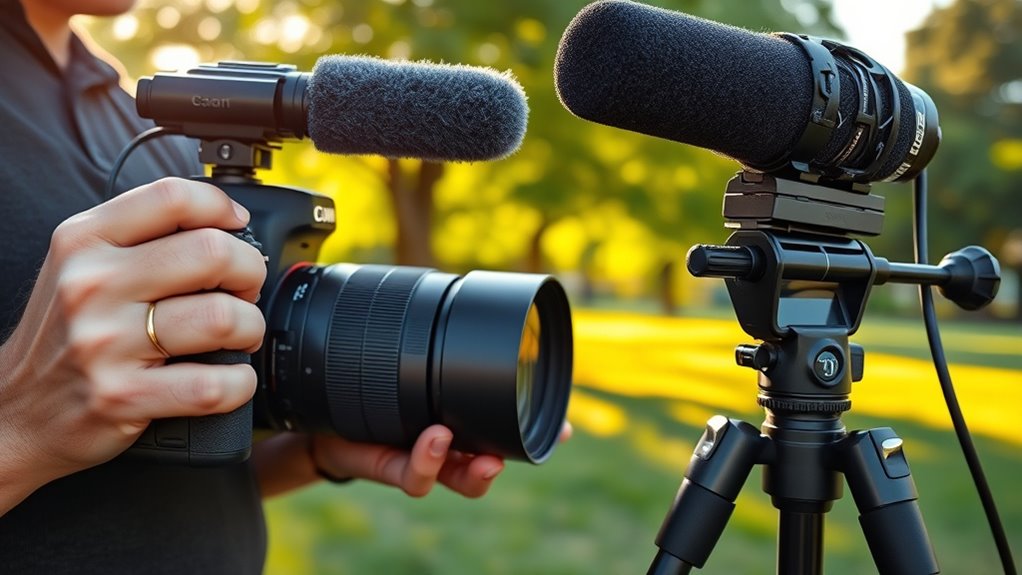Choosing between an on-camera mic and a shotgun depends on your environment and project needs. On-camera mics are simple and portable, ideal for quick shoots and vlogging but often pick up more ambient noise. Shotgun mics offer focused, directional audio, perfect for outdoor or distant subjects but require proper placement and wind protection. If you want to master the nuances between these mics, there’s more to discover that can help you get professional-quality sound.
Key Takeaways
- Shotgun mics are highly directional, ideal for isolating sound from a distance, while on-camera mics have broader pickup patterns for quick setups.
- On-camera microphones are more portable and easier to use, making them suitable for vlogging and fast-paced shooting environments.
- Shotgun mics offer better noise rejection outdoors, especially with windshields, compared to on-camera mics that capture more ambient sound.
- Proper placement and proximity are essential for both, but shotguns require precise aiming to maximize focus and minimize ambient noise.
- Budget, environment, and project needs influence whether a shotgun or on-camera mic is the best choice for professional or casual recording.
Understanding the Basic Designs and Structures
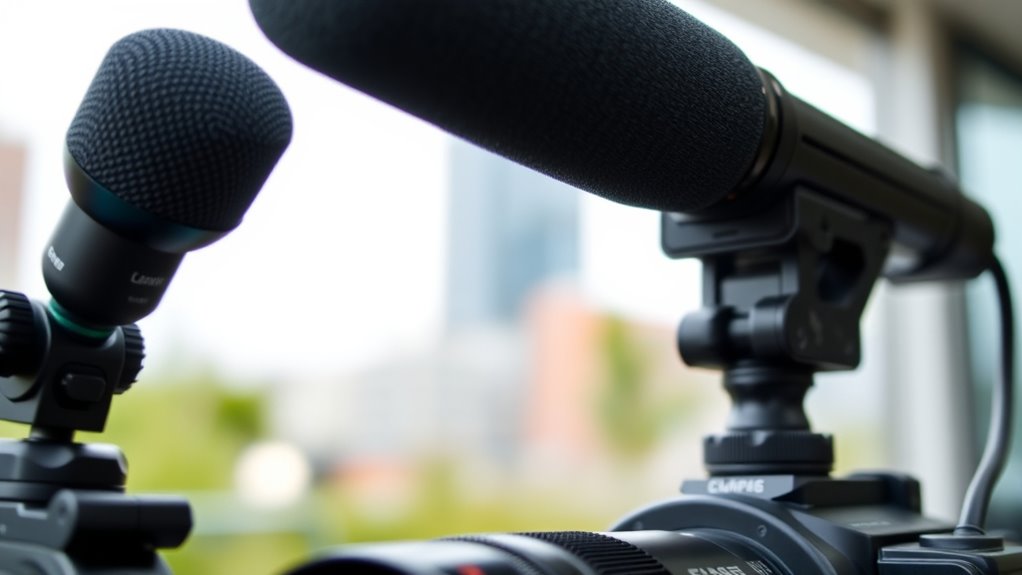
To understand the differences between on-camera microphones and shotguns, it’s essential to grasp their basic designs and structures. The key lies in their polar pattern, which determines how they pick up sound from different directions. On-camera mics typically have an omnidirectional or cardioid polar pattern, capturing sound from all around or mainly from the front. Shotgun microphones, on the other hand, feature a highly directional polar pattern, focusing on sound directly in front of them. Their capsule design is also distinct; shotgun mics often have a long, narrow form with an interference tube that helps reject side noise. This design enhances their ability to isolate distant sound sources, making them ideal for capturing audio from a distance while minimizing ambient noise. Additionally, understanding the polar pattern of each microphone type can help users choose the appropriate mic for their specific recording environment.
Typical Use Cases for On-Camera and Shotgun Microphones
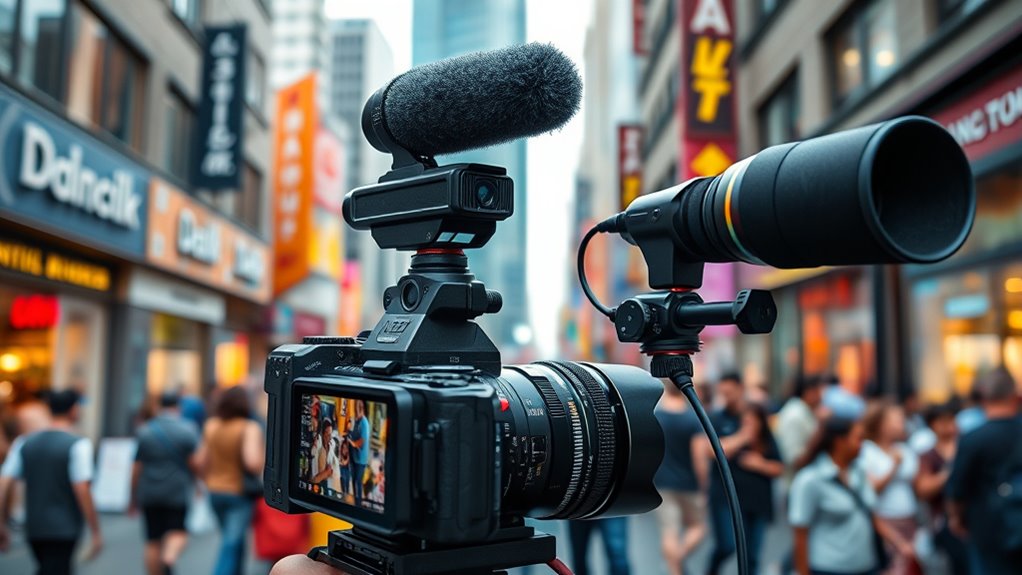
You’ll find on-camera microphones perfect for vlogging and content creation, offering quick setup and mobility. Shotgun mics excel during event recordings, interviews, and documentary work, capturing focused sound from a distance. Understanding these use cases helps you choose the right mic for your specific filming needs. Additionally, selecting the appropriate microphone type can enhance your overall production quality by matching the industry trends and your content style.
Vlogging and Content Creation
When it comes to vlogging and content creation, choosing the right microphone can make a significant difference in audio quality. Clear, consistent sound enhances viewer engagement and reflects professionalism. On-camera microphones are ideal for capturing your voice directly and are easy to use with minimal setup, while shotgun mics excel at isolating your voice from background noise. Proper audio signal processing ensures your recordings sound polished, and regular microphone maintenance keeps your gear performing at its best. Additionally, understanding the target audience and their environment can help you select the most suitable microphone type for your specific needs.
Event and Interview Recording
In event and interview recording, capturing clear, focused audio is essential for audience engagement and professionalism. On-camera microphones excel here, offering quick setup and mobility, especially with wireless options for freedom of movement. Shotgun mics provide superior directionality, reducing background noise and emphasizing the speaker’s voice. Wind reduction features help minimize outdoor interference, ensuring clean audio even in windy conditions. Consider this comparison: Symbols represent transformation and enlightenment, which can be visually linked to the concept of focusing sound toward the microphone’s capsule.
| Microphone Type | Best Use | Key Features |
|---|---|---|
| On-Camera Mic | Interviews, events | Wireless options, easy setup |
| Shotgun Mic | Outdoor interviews | Directional, wind reduction |
| Both | Versatile use | Suitable for different environments |
Choosing between them depends on your environment and need for mobility versus focused sound.
Documentary and Field Work
Documentary and field work demand reliable audio capture in unpredictable environments, making the choice of microphone vital. You need equipment that can handle varied conditions, provide clear sound, and operate without constant intervention. On-camera mics are convenient for quick setups, but shotgun microphones excel at isolating sound from a distance, especially in noisy areas. Wireless connectivity is essential, allowing you to move freely without cable restrictions, while long battery life ensures your device won’t cut out mid-shoot. Consider these factors:
- Directionality and pickup pattern
- Durability in outdoor conditions
- Compatibility with your camera setup
- Battery longevity and wireless features
- High dynamic range helps ensure audio quality remains consistent across different environments and sound levels.
Differences in Directionality and Pickup Patterns
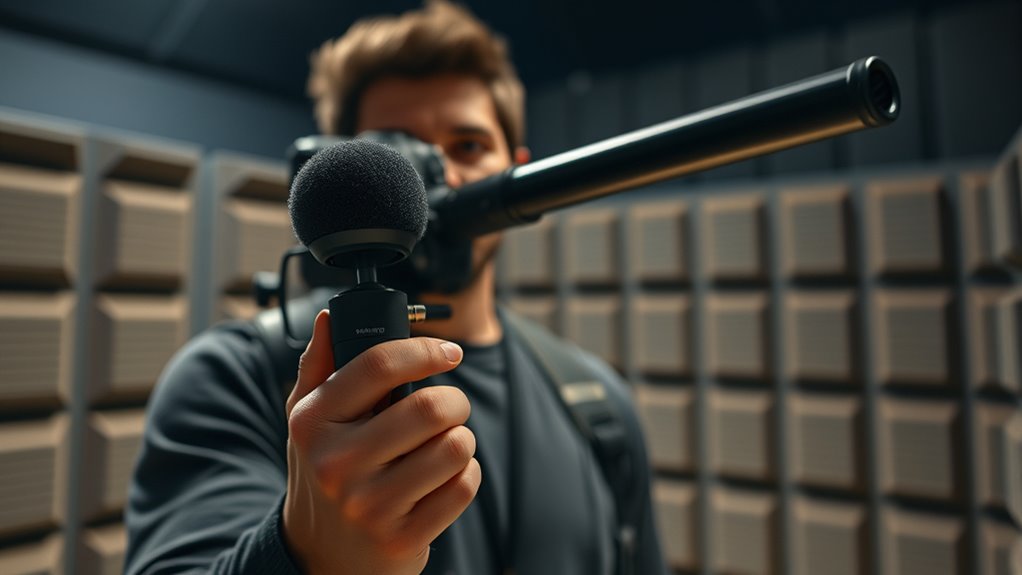
On-camera microphones typically have a wide or supercardioid pickup pattern, capturing sound from a large area around the camera while rejecting some noise from the sides and rear. This polar pattern makes them suitable for general use but less effective at isolating specific sound sources. Shotgun mics, on the other hand, feature highly directional polar patterns, focusing on sound directly in front while minimizing ambient noise. Their narrow pickup pattern allows you to target a subject from a distance. Additionally, these microphones often have a tailored frequency response that enhances speech clarity and reduces background noise. Understanding these differences in directionality and pickup patterns helps you choose the right microphone for your environment, ensuring ideal sound quality and minimizing unwanted noise. Moreover, the types of microphones available are designed with specific environments in mind, which can significantly impact your recording quality.
How Distance Affects Sound Quality

As you move farther from your microphone, sound clarity can start to drop, making your audio less crisp. Both on-camera mics and shotguns have limited pickup ranges, so staying within that range is essential. Understanding how distance impacts quality helps you choose the right mic and position for clear, professional sound. Additionally, proper placement can help minimize background noise and improve overall audio performance, which is especially important for home security system recordings.
Sound Clarity Loss
When the microphone is farther from the sound source, the clarity of the recorded audio tends to decrease considerably. As your distance increases, background noise becomes more prominent, making it harder to isolate the main sound. Wind interference can also distort the audio, especially outdoors, causing muffled or crackling sounds. This loss of clarity can lead to a muddy or indistinct recording, reducing overall quality. To minimize these issues, consider proximity and proper microphone placement. Additionally, understanding how environmental factors impact sound will help you optimize your setup. Implementing sound isolation techniques can further improve audio quality by reducing unwanted noise and interference.
Pickup Range Limits
The distance between your microphone and the sound source directly impacts the quality of your recordings. As you move farther away, sound diminishes, and background noise increases, especially if you’re using on-camera mics or shotgun mics. Wireless options can help extend your range, but they have limits. Proper wind protection becomes essential when capturing audio at longer distances or outdoors. Additionally, understanding water park amenities can help you choose the best equipment to handle different environments and conditions.
Compatibility With Different Camera Systems
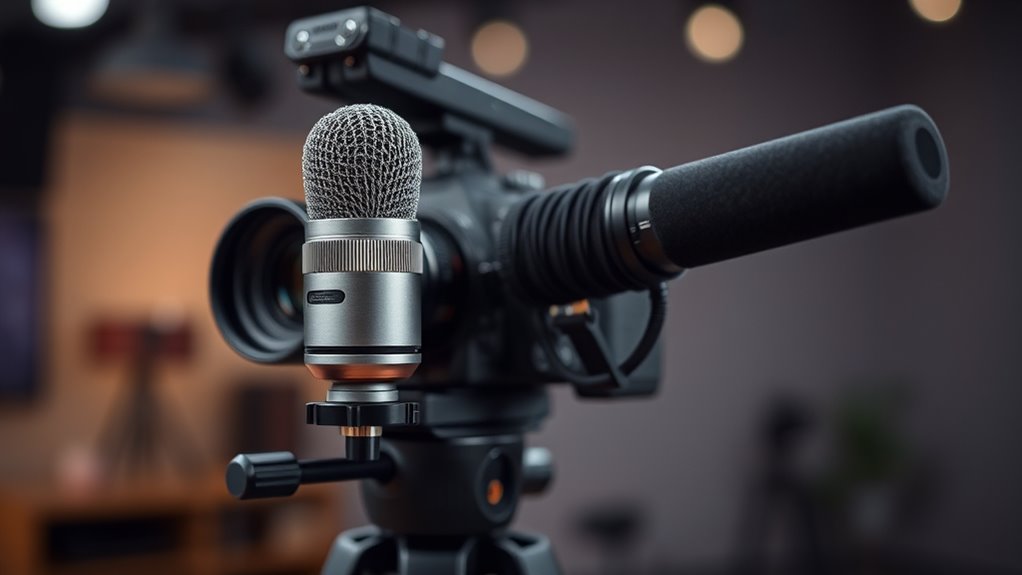
Compatibility with different camera systems varies markedly between on-camera mics and shotgun mics. On-camera mics often feature standard 3.5mm jacks, making them broadly compatible with many DSLR and mirrorless cameras. Shotgun mics, however, may require specific mounts, adapters, or audio interfaces, especially when integrated with professional cinema cameras. Factors like wireless connectivity options can enhance flexibility across systems, but compatibility issues may arise if your camera lacks Bluetooth or Wi-Fi support. Battery longevity also varies; on-camera mics typically draw power directly from the camera, while shotgun mics often have dedicated batteries, affecting portability and setup. Additionally, understanding system compatibility is crucial for ensuring seamless integration with your existing gear.
Setup and Mounting Considerations
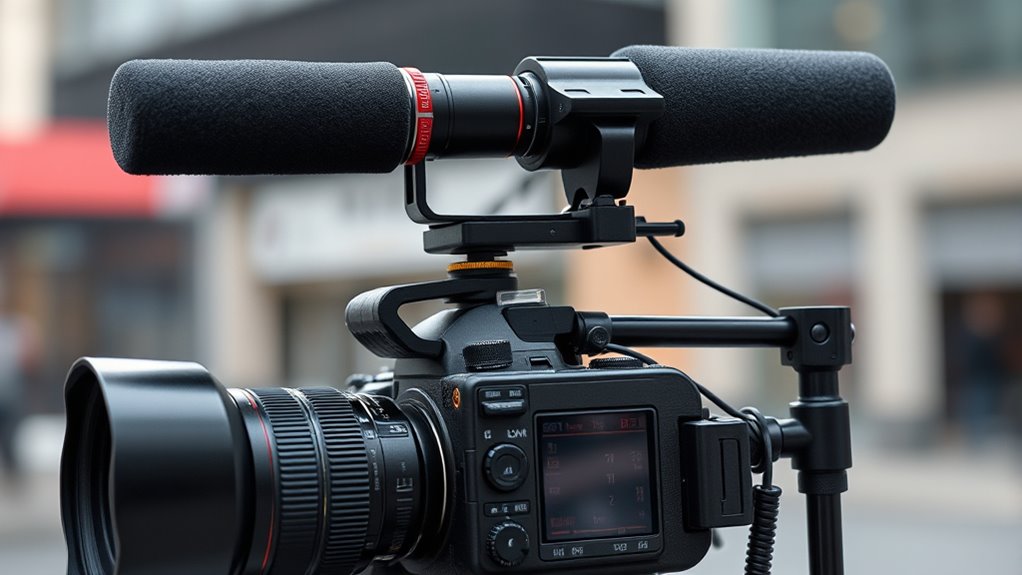
Choosing the right setup and mounting options can considerably influence your audio quality and ease of use. When selecting a microphone, consider its polar pattern, as this determines how it captures sound from different directions. A shotgun mic with a highly directional polar pattern focuses on the subject, reducing background noise, while an on-camera mic with an omnidirectional pattern picks up sound more evenly. Mounting options are equally important; ensure your microphone is securely attached to prevent handling noise and vibrations. Use shock mounts or windshields as needed to improve clarity and reduce unwanted noise. Proper positioning and stable mounting not only enhance audio quality but also make your setup more convenient and professional-looking. Additionally, understanding the relationship between microphone placement and sound capture can help you optimize your audio setup for various shooting environments.
Limitations and Common Challenges
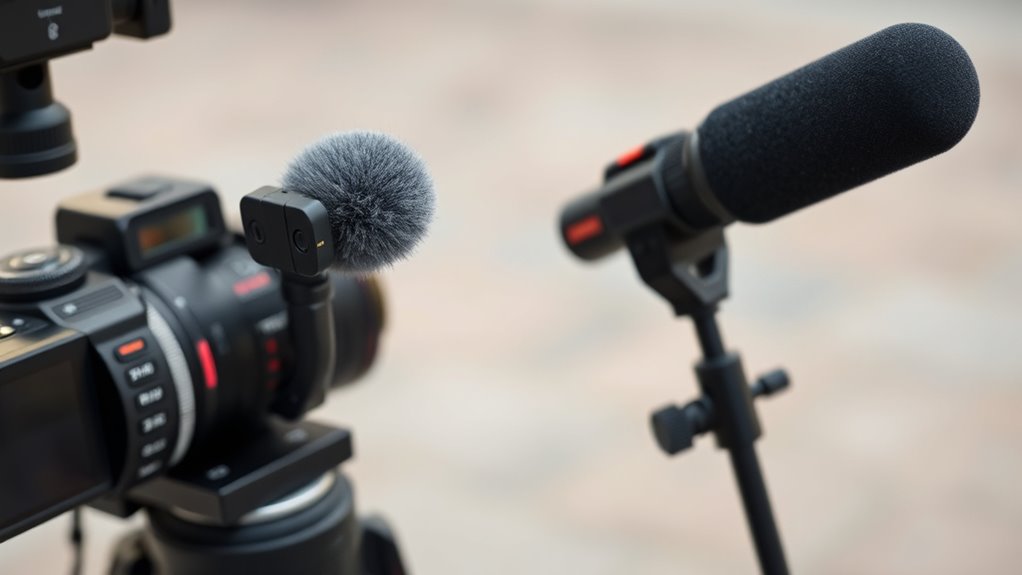
While on-camera mics and shotgun microphones each have their strengths, they also come with notable limitations. Wind noise can severely affect audio quality, especially in outdoor settings, making it essential to use windshields or dead cats. Shotgun mics often have limited battery life, requiring you to carry spare batteries or power sources during shoots. On-camera mics tend to pick up more ambient noise, reducing clarity in noisy environments. Additionally, both microphone types can struggle with focusing precisely on the subject if not properly aimed, leading to inconsistent audio. Understanding these challenges helps you better prepare for real-world conditions.
- Wind noise interference in outdoor recordings
- Limited battery life impacting shoot duration
- Ambient noise pickup reducing clarity
- Difficulty in achieving precise focus
Cost and Budgeting for Your Audio Gear
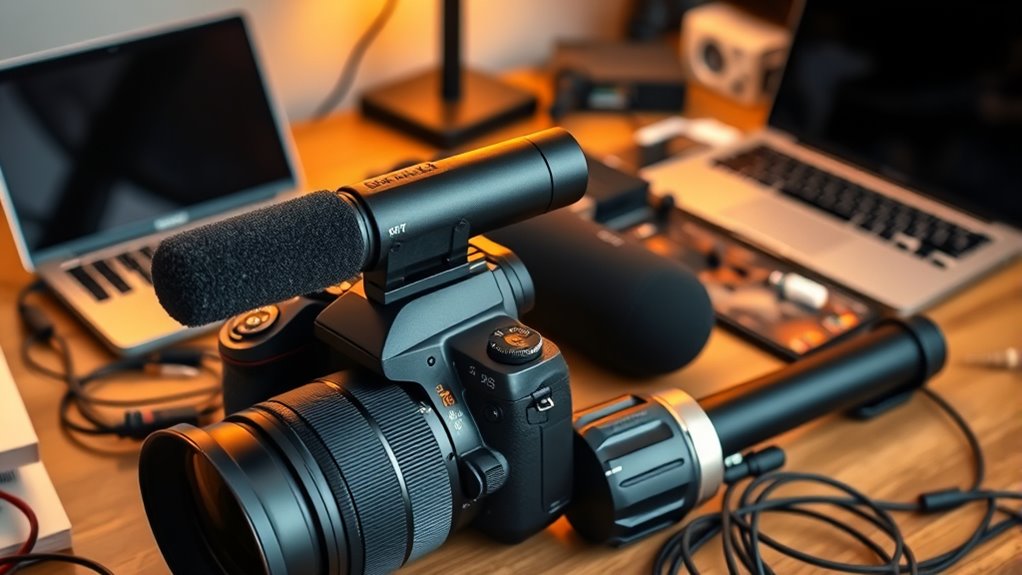
Budget considerations play a significant role in selecting the right audio gear for your projects. Proper budget planning helps you balance quality with affordability, ensuring your equipment investment aligns with your needs. When choosing between on-camera mics and shotguns, consider both initial costs and long-term expenses like maintenance or upgrades. Here’s a quick comparison:
| Aspect | On-Camera Mic | Shotgun | Cost Range |
|---|---|---|---|
| Initial Price | Lower | Higher | $50 – $300+ |
| Portability | Very portable | Less portable | $50 – $600+ |
| Suitability | Casual, quick shoots | Professional, controlled env. | $100 – $500+ |
| Maintenance | Minimal | Moderate to high | Varies |
Investing in audio equipment that fits your project’s scope and budget ensures you get the best sound without overspending. Thoughtful equipment investment ensures you get the best sound without overspending, fitting your project’s scope and budget.
Best Practices for Audio Recording in Various Environments
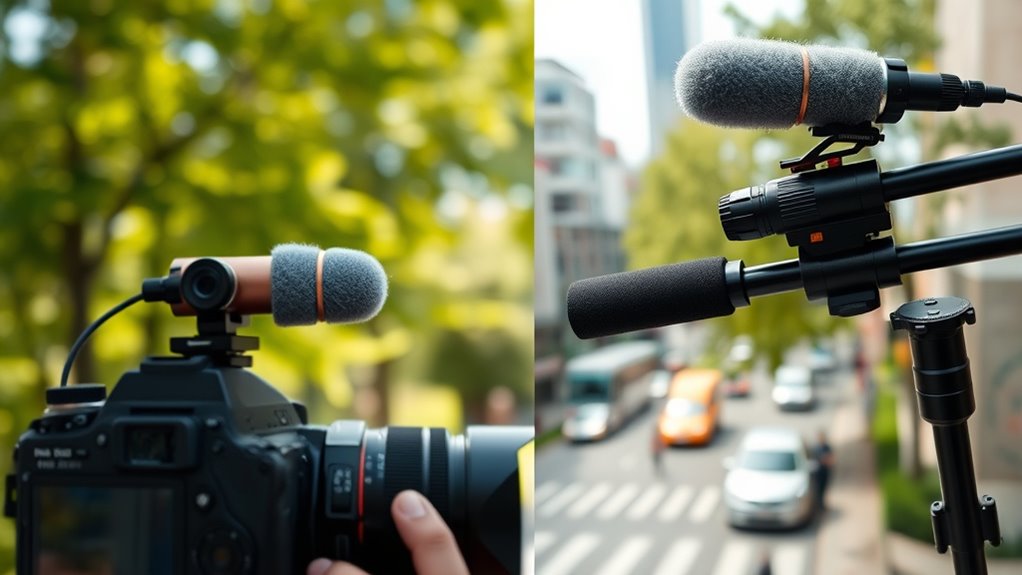
To get the best sound quality, you need to manage environmental noise effectively and position your microphone correctly. Adjust your setup based on different conditions to minimize unwanted sounds and capture clear audio. Little tweaks in placement and noise control can make a big difference in your recordings. Regularly monitoring your audio equipment and environment ensures consistent sound quality and helps identify issues early, such as proper maintenance practices.
Environmental Noise Control
Controlling environmental noise is essential for capturing clear audio, regardless of whether you’re using an on-camera mic or a shotgun. Ambient noise and wind interference can ruin your recordings if not managed properly. To minimize these issues, consider the following best practices:
- Choose locations with minimal ambient noise and avoid crowded or noisy areas.
- Use windshields or dead cats to reduce wind interference during outdoor shoots.
- Schedule recordings during quieter times of day to limit background sounds.
- Employ sound barriers or reflective surfaces to block or redirect unwanted noise sources.
- Be aware of state-specific tax laws that could impact your overall budget for equipment and production costs, especially when planning outdoor or long-term shoots.
Implementing these techniques helps ensure your audio remains crisp and intelligible, even in challenging environments. Proper noise control allows your primary sound source to shine, making your recordings more professional and engaging.
Microphone Placement Tips
Proper microphone placement can make the difference between clear, professional audio and unusable recordings. Keep your mic close to the source, usually within a few inches, to minimize wind interference and capture sound accurately. When outdoors, position the microphone away from wind gusts or use a windscreen to reduce noise. Be mindful of your environment; avoiding reflective surfaces helps reduce echo. Also, consider battery life—placing the mic where it can conserve power ensures longer recording sessions. For on-camera mics, keep them pointed directly at the subject to enhance clarity. Shotgun mics work best when aimed precisely at the sound source, avoiding extraneous noise. Proper placement maximizes audio quality, reduces wind interference, and extends battery life, ensuring your recordings are crisp and professional. Additionally, selecting the appropriate headphone jack type can improve monitoring accuracy during recording sessions.
Adapting to Conditions
Adjusting your microphone setup to suit different environments guarantees you get clear, professional sound regardless of conditions. When recording outdoors, use windshields or dead cats to reduce wind noise. For indoor settings, consider room acoustics—soft furnishings help minimize echo and improve clarity. In noisy environments, position your mic closer to the sound source or use directional microphones to isolate audio. Be mindful of reflective surfaces that cause unwanted reverberations and adjust your setup accordingly. Additionally, understanding the Gold IRA Rollovers process can help you effectively diversify your investment portfolio for better financial security.
- Use windshields or foam covers outdoors to combat wind noise
- Position mics closer to the sound source indoors for better clarity
- Employ directional mics to isolate dialogue in noisy settings
- Add acoustic treatments or barriers to manage indoor reverberations
Tips for Choosing the Right Microphone for Your Projects
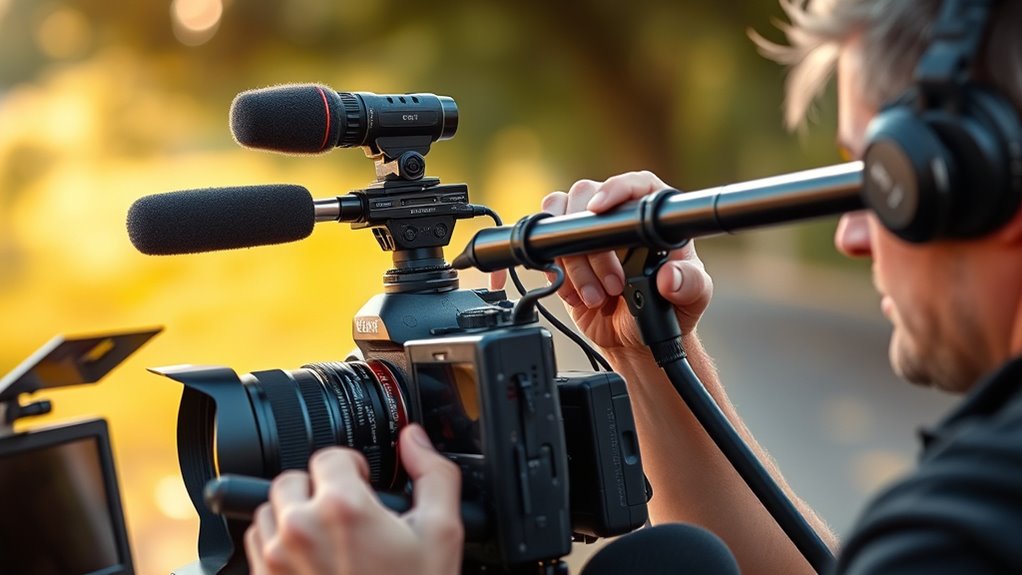
Choosing the right microphone for your projects starts with understanding your specific recording environment and goals. If mobility is key, consider wireless options for flexibility without sacrificing quality. Look into microphones that offer reliable power supply options, whether batteries or phantom power, to ensure consistent performance during shoots. Think about your environment—indoors or outdoors—and select a microphone suited for that setting. Directionality also matters; on-camera mics work well for general use, while shotguns excel at isolating sound from a distance. Always evaluate compatibility with your camera or recording device and consider your budget. By focusing on these factors, you’ll make a more informed decision that enhances your audio quality and fits your project’s needs. Additionally, understanding microphone types can help you choose the best device for your specific recording situation.
Frequently Asked Questions
Can On-Camera Mics Handle Loud Environments Without Distortion?
On-camera mics can handle loud environments, but their performance depends on their dynamic range. If the mic has a wide dynamic range, it can capture loud sounds without distortion. However, in extremely noisy settings, you might experience some distortion or clipping. To avoid this, use microphones with good attenuation features or add a windscreen. Always test your gear beforehand to guarantee it handles loud sounds effectively.
How Do Windshields Impact Shotgun Microphone Performance Outdoors?
Ever wonder if windshields truly shield your shotgun mic outdoors? They markedly improve windshield effectiveness, reducing wind noise and enhancing outdoor noise reduction. With a good windshield, you’ll notice clearer audio even in gusty conditions. Without one, wind can create harsh, unusable sound. So, investing in quality windshields isn’t just smart—it’s essential for capturing professional-quality sound in outdoor environments. Wouldn’t you want your audio to sound as good as your visuals?
What Are the Best Settings for Recording in Low-Light Conditions?
In low-light conditions, you should boost your camera’s ISO and open the aperture wider to gather more light. Use audio compression to even out volume levels, and activate noise reduction to minimize background noise. Keep your microphone close to the sound source to improve clarity, and consider recording in manual mode to control exposure settings precisely. These adjustments help you capture clearer visuals and audio despite the dim environment.
Are There Wireless Options for On-Camera and Shotgun Microphones?
Imagine cutting the cord and gaining freedom—yes, wireless options exist for on-camera and shotgun microphones. You can find models with wireless connectivity that offer reliable performance, often within a specific frequency range to avoid interference. These mics enable you to move freely without sacrificing sound quality, making them ideal for dynamic shoots. Just check the frequency range to verify compatibility and minimize potential signal disruptions.
How Do Microphone Sizes Affect Mobility and Handling During Shoots?
Larger microphones can hinder your mobility and handling ease during shoots, making them bulky and harder to maneuver quickly. Smaller microphones, on the other hand, offer better microphone portability, allowing you to move freely and handle equipment comfortably. If you need agility and quick setup, opt for compact mics that enhance handling ease, so you can focus on capturing high-quality audio without feeling weighed down or restricted.
Conclusion
Choosing between an on-camera mic and a shotgun isn’t just about specs; it’s about capturing the mood and emotion of your story. While a shotgun can deliver focused clarity in noisy settings, an on-camera mic offers convenience and versatility for spontaneous moments. Your choice shapes your soundscape—sometimes sharp and precise, other times warm and intimate. Ultimately, the right mic elevates your project, making your audience feel truly connected to your vision.

